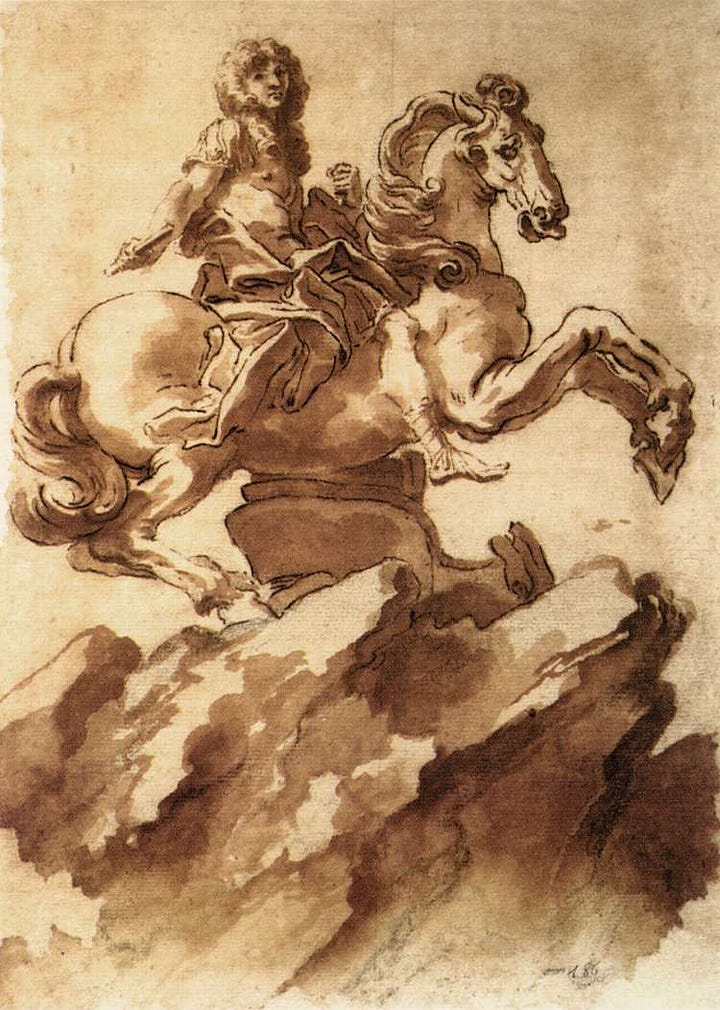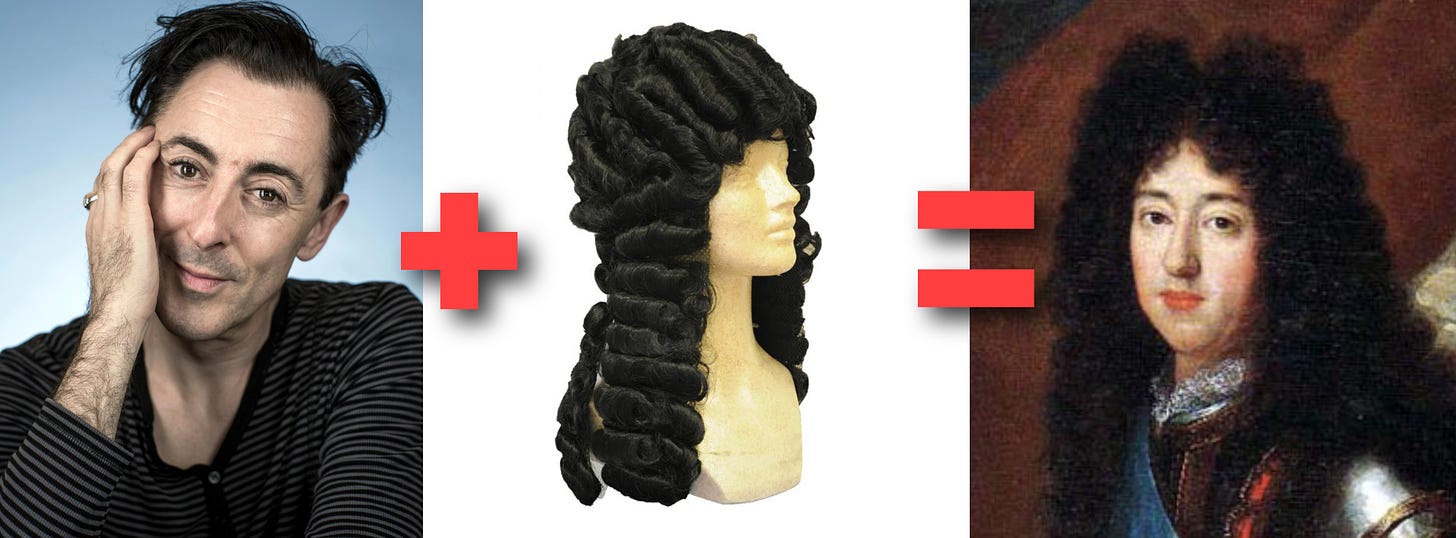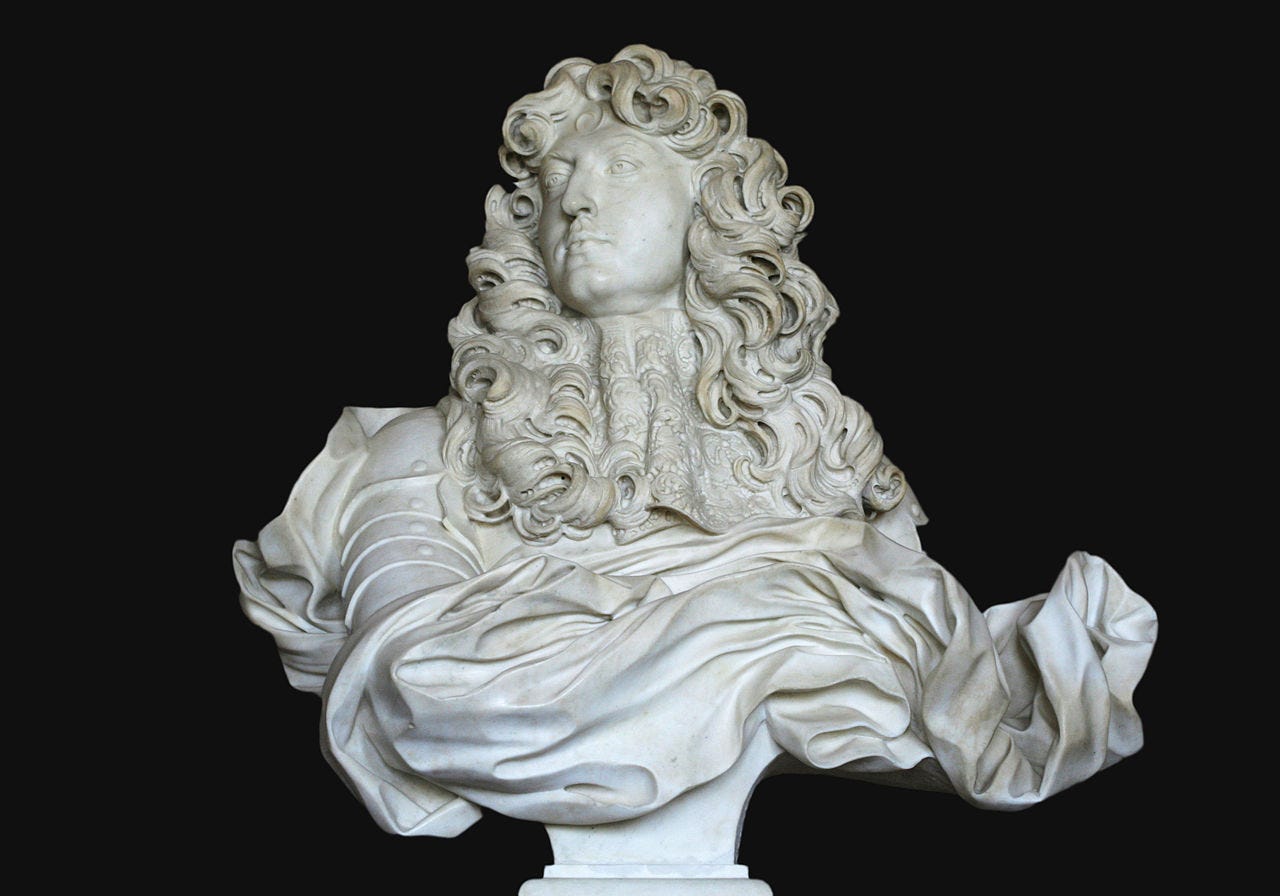Gianlòllo in Paris [in English]
This is an experiment to check if non-Italian readers are interested in my ramblings about baroque stuff...
A few nights ago I dreamed of Pedro Pascal (and I blame Daniela Losini and Stefania Pecere for that, as per usual).
[voice from the back] “Excuse me, I thought this was a newsletter about Baroque stuff…”
I'm getting there, please stay with me… So, I dreamed of Pedro Pascal as he was portraying Gian Lorenzo Bernini in the movie based on the historical fantasy novel I'm writing, in which the main character is Philippe d'Orléans (who of course will be portrayed by Alan Cumming in the movie — yup, I’m not done yet with writing the book, but I've already thought of half of the cast for the movie…).
After all, if Riccardo Scamarcio could portray Caravaggio, it's a free-for-all...
[same voice from the back as before] “What’s the deal between Bernini and Philippe d'Orléans?”
Thanks for asking this: in 1665 Gian Lorenzo Bernini travelled to Paris, by request of the French king, Louis XIV, by means of Jean-Baptiste Colbert, his ministry of finance, and as Paul Fréart de Chantelou relates in his Journal de voyage du Cavalier Bernin en France, he also met Philippe d’Orléans, who commissioned him a project for a fountain for his park in Saint-Cloud, where Monsieur had his favourite residence.



(yes, I'm well aware that in 1665 Bernini was already 67 years old, and that Pedro Pascal is about two decades younger than that, and I'm also aware that Philippe d'Orléans was 25 while Alan Cumming is currently 58, BUT, beside the existence of Hollywood makeup and knowing that Alan Cumming is not acting his age, I wonder: for a whole five years it was okay for y’all for Gabrielle Carteris to portray a 30something teenager, and your suspension of disbelief fails you right now? Seriously? C’mon…)
But let's start from the beginning: why Bernini had been requested in Paris?
Louis XIV was renovating the Louvre palace, so instead of seeking help from Jonathan and Drew Scott, he called for “le cavalier Bernin” straight from Italy, asking him to design a new façade for the palace, as the existing one was in Renaissance style, therefore out of fashion. While he was in Paris, Bernini also worked on a marble bust portrait of Louis XIV, which is regarded by Rudolf Wittkower, *the* boss of all Baroque historians, as one of the masterpieces of Baroque art.
Unfortunately, the Sun King deemed both the design (or rather the THREE designs) for the façade of the Louvre and the marble portrait as “too Italian”, too much for French taste (i.e. for his taste, ça va sans dire)…

The same happened years later with the equestrian statue of King Louis XIV, which Bernini started working on once he returned to Rome, but was only sent over to France after Bernini’s death: once the statue arrived in Paris, the king pulled one of those disdainful faces only the French are capable of, exclaiming “it doesn't look like me!” (but in French), thus shoving it into the orangerie in Versailles, then moving it near the Neptune Fountain. Still unsatisfied, the king almost decided for it to be destroyed, but he then thankfully changed his mind and asked François Girardon, a French sculptor who had already worked on several statues decorating Versailles, to modify Bernini’s sculpture, deciding it was no longer his equestrian portrait, but that of Marcus Curtius, moving it for a third time, in the proximity of the Lake of the Swiss Guards... Ah, whatever.


But what about Bernini and Monsieur, then?
As I mentioned earlier in this post, during his stay in France, Bernini also met our favourite Bourbon, the Duc d'Orléans, Philippe, also known as Monsieur, frère unique du roi, who commissioned him a design for a monumental fountain inside the park of Saint-Cloud.
Chantelou writes about this in his Journal: «L'après-dînée, il a été à Saint-Cloud, dont il a trouvé la situation extrémement belle à cause de la vue et des eaux. Il a trouvé qu'on pourrait faire une cascade rustique au carré où est le grand jet d'eau, laquelle parmi des choses si ajustées serait d'une grande beauté...» — in short: Bernini liked what he found in Saint-Cloud, and thought that a rustic-style cascade would've fit in well, breaking the regular geometries of the existing basins.
As historian Rosario Villari wrote, the 17th Century was “il gran secolo della dissimulazione” (the great century of dissimulation), so Bernini, after having closely observed for some time the spectacular water games of the existing fountains in Saint-Cloud, believed that any artificiality should’ve been hidden, turning the existing fountain into a natural-looking cascade, and after a few weeks he gave Chantelou a few drawings of his idea:
«I’m pretty sure they won't like it. They're not accustomed to nature-resembling fountains like this, they prefer geometry and smaller manufacts, like nuns’ embroideries…» — Gianlorenzo Bernini, who by then had realised the French wouldn't have let him build anything…
Bernini also commissioned a painted view to be made to better illustrate how his design would've looked like once built, but the Duc d’Orléans wasn't persuaded, as he similarly wasn't persuaded by Bernini's suggestions to ameliorate the Grande Cascade facing the river Seine, the one designed by Le Pautre (who had been inspired by the terraced fountains in Italian Renaissance gardens, like those in Villa Lante in Bagnaia and Villa Aldobrandini in Frascati) — unfortunately though no drawings survived to our days, we can only rely on Chantelou’s Journal.
Bernini left Paris for Rome on 20th October 1665, and Chantelou reports that only after his departure the French court started worrying about his reaction to their rejection(s), especially that of his designs for the Louvre — and to better express their preoccupation, they started gossiping about him, claiming he was too full of himself and that he wasn't worthy of the King’s munificence...
If the court gossiping wasn't enough, Monsieur added to that as well (he was generally a nice, cheerful chap, but he couldn't keep a secret, and since the King kept him from tackling any role in the government, he was constantly bored, thus resorting to gossip as a pastime…), as he kept telling everyone that the King believed Bernini had left France unsatisfied. He told that also to Chantelou, who in the meantime was trying to shut all these rumours down…
«Mais le Roi le croit…» (but the King believes so), Philippe replied to Chantelou, «le Roi dit qu'il le sait d'un lieu à n'en pas douter» (the King said he's been told that by a reliable source).
Who was this “reliable source”, I wonder? Reasonable suspicion falls on the King’s ministry of finance, Colbert, who never really liked Bernini, to whom he preferred (and constantly commended) “l’architecte du Roi”, Louis Le Vau, one of the architects who contributed to the development of the so called French Classical style.
Chantelou rushed to write a letter to Bernini, hoping he could deny all rumours once and for all: «Je vous ai mandé par le dernier ordinaire le bruit qui s'est répandu que vous êtes parti mécontent, que Monsieur m'en avait parlé et m'avait dit que le Roi en était persuadé. […] Hier soir, Sa Majesté à son souper me demanda tout bas si cela était vrai; je l'assurai que non, qu'au contraire, je vous avais vu très satisfait de l'honneur que vous aviez reçu, de l'estime que Sa Majesté vous avait fait paraître et de ses bienfaits…» (in short: he told Bernini about the rumours and the King's alleged belief that he'd left France disappointed by him, and added that he'd tried to persuade the king otherwise).
Bernini, who was still travelling, having just arrived in Lyon, replied very emphatically in Italian (you should picture Bernini gesticulating like a madman while speaking the following words): «…se Iddio benedetto mi darà vita, farò veder non con parole, ma con gli effetti a sua Maestà e a tutto il mondo, quanto io sia restato obligato et innamorato di un sì gran Re...» (if God, blessed be him, grants me enough life, sure enough I'll show his Majesty and the whole world how grateful I am and how enamoured of such a great King, not with words but with facts…).
Anyway, bottom line is gossip has always been ruling the world.








I'm happy with both versions. I'm learning Italian so I like I can find Italian Substacks. :D.
Have always been fascinated by the rivalry between Bernini and Borromini.. fyi I wrote the film Pope's Exorcist based on the writings of Gabriele Amorth so if you ever finish that novel I sure would love to see what kind of movie it might make!